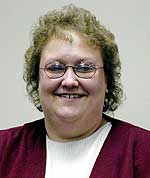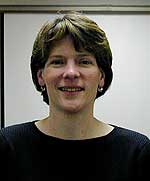By Cara Hetland
Minnesota Public Radio
May 28, 2002
Some families in Sioux Falls, S.D., who have lost a relative to suicide are trying to help others get through similar tragedies. They've formed a group called LOSS, Local Outreach to Suicide Survivors. They arrive shortly after a body has been discovered in order to offer support to the family. In Sioux Falls, there are an average of two suicides every month. Officials believe if more people talk about suicide - it will help prevent other suicides.
| |
|
|
|
||
About two dozen people who lost a family member to suicide turn out to watch a new video, comprised of photos set to music.
"Your hand is cold, it once held mine, I can't believe you really left this world behind," is one line of the song.
The photos are of Sioux Falls residents who committed suicide. The video was created to put a local face on suicide. It'll be shown in prevention hotline training classes and to local politicians.
Sandy Parham watches and cries as her brother's face flashes across the screen. It's been 12 years since Brian Parham parked on a secluded Sioux Falls street and shot himself. Sandy says that's a night she'll never forget.
"We had been out looking for him. Actually, I found him while he was still alive. But I was unable to get through to him because he had already made up his mind, and he wouldn't let me talk to him," Sandy Perham recalls. "After he already died, my father happened to drive down that road and found him."
Sandy Parham says her brother had been depressed. She says he was a self-described perfectionist who could not tolerate failure. He had just broken up with a girlfriend. Parham says when he threatened to kill himself, family members took him for counseling.
| |
|
|
|
||
But the counselor told the family Brian was not the type to actually go through with suicide - rather he was seeking attention because he was spoiled.
"You have to take people seriously when they talk about suicide," says Parham. "There's not a certain type person that's going to complete suicide - it can happen to anybody."
Sandy Parham says she felt angry and guilty for many years after her brother's death. Parham says she's been able to cope by helping people in similar situations. Perham coordinates the Sioux Falls suicide prevention hotline. At least 50 people a month call the hotline. They are mostly women reaching out for themselves or a family member.
Last year 29 people completed suicide in Minnehaha County. Twenty-three of them were men. The average age was 40. South Dakota ranks 12th in the nation for the number of deaths by suicide.
Sandy Parham has met most of the victims' family members. She's part of a team of suicide survivors who go out with a mental health professional immediately when a person commits suicide. Parham says the goal is to talk to the family members, and let them see that they can get through it. Parham says it's not something you ever get over.
"You don't ever move on - you live with the scar of the pain. Your life is forever different than it would have been," Parham says.
|
"It's not funded very well because it's a difficult subject. People don't want to talk about it, and so they just want it to go away."
- Janet Kittams-Lalley, on suicide prevention efforts |
Suicide prevention is slowly climbing up the national agenda. Last year the U.S. Surgeon General ordered the creation of a national strategy to provide various services and programs. It's the first time suicide has been looked at as a public health problem. Each state is now supposed to review the national goals and objectives, and communities are to implement them.
"They haven't found the best way. I think we're still struggling to reach the vast majority of people," says Janet Kittams-Lally, director of the Sioux Falls crisis line.
She says suicide is more of a problem now than it's ever been. But she says people refuse to talk about the issue, and prevention efforts need more money.
"It's not funded very well because it's a difficult subject. People don't want to talk about it, and so they just want it to go away," says Kittams-Lally. "But there needs to be more dollars put toward educating people about suicide prevention, and getting knowledge out there to everybody that there is help. It's as simple as calling and reaching out, and knowing where to go."
Kittams-Lalley says there's a national hotline, 1-800-SUICIDE, for people who are considering suicide. She says family members also can call for advice if someone is depressed or showing signs of being suicidal. Kittams-Lalley says the more people talk about suicide and prevention - the more people will seek help.
More Information

